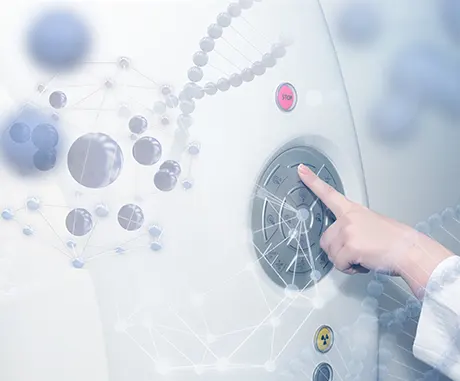The theoretical foundations for nuclear magnetic resonance were laid in 1924 when the physicist Wolfgang Ernst Pauli first described the nuclear spin. In 1946, Felix Bloch and Edward Purcell independently understood nuclear magnetic resonance (NMR), i.e. the resonance absorption of electromagnetic radiation by atomic nuclei in a strong, high-frequency magnetic field. In 1952, Bloch and Purcell were awarded the Nobel Prize in Physics for their work.
At first, magnetic resonance technology was only used for spectroscopy, i.e. in the field of materials science. The radio waves reflected by the magnetic “activation” allowed it to draw conclusions about the ingredients of the examined material. At that time, it was not yet possible to use the technology for medical diagnostics. Although the ingredients could be identified, the signals could not be spatially assigned. In other words, it was not yet possible to generate a sectional image on which, for example, the position of an injury or a tumor could be shown.
On the path to medical usage
For use in medical diagnostics, the possibility to assign the signals within the space was still lacking. The additional magnetic fields required for this – which are called gradient fields – were introduced by the American Paul Lauterbur in 1973. It is these gradient coils that, due to the frequent switching of the magnets, produce the loud noise that patients often describe as unpleasant. And from 1974 onwards, British scientist Peter Mansfield developed mathematical methods based on Fourier that made it possible to convert radio frequency signals into image signals.
As a result of the works of Mansfield and Lauterbur, nuclear magnetic resonance could be further developed into magnetic resonance imaging (MRI). It was not until 2003 that the two were jointly awarded the Nobel Prize for Medicine and Physiology for their research in the imaging technology of magnetic resonance imaging (MRI), which is so valuable for diagnostics.
The use of MRI in diagnostics
It was not until 1977 that R. Damadian succeeded in taking the first image of the human body. The resolution of these images was not yet sufficient for diagnostic use and the recording times were still several hours. In 1981, tumor tissue could be distinguished from healthy tissue for the first time. In 1983, the first MRI prototype was installed by Siemens at the Hannover Medical School and tested on over 800 patients over the next few years. MRI was increasingly accepted clinically, partly because of its advantages, e.g. the high soft tissue contrast and the lack of radiation exposure. The imaging procedure provides highly valuable and accurate images of body tissue in a gentle manner. In modern diagnostic imaging, magnetic resonance imaging (MRI) is one of the gold standard methods. Gold standard in medicine means a diagnostic, therapeutic or general scientific procedure that represents the most proven and best solution in a given case. New procedures are measured against this gold standard.
Advantages of MRI
MRI is one of the most modern, safest and gentlest methods for detecting pathological changes inside the body without harmful X-rays. With modern MRI scanners, the location, extent and cause of a specific disease can be visualized much better than it is possible with conventional methods such as X-ray examinations or ultrasound.
From MRI to MBST therapy
In the early days of MRI, patients often had to be examined several times. The computers were not yet as powerful as they are today, so even a slight movement of the patient blurred the image. If the patient was not holding still at the crucial moment, the process had to be repeated.
Time and again, patients with joint problems reported that their symptoms had improved after several MRI scans. This was initially inexplicable to the doctors. They suspected a placebo effect.
Axel Muntermann, the developer of therapeutic magnetic resonance, also heard of these reports. He thought that there might be more to these improvements than placebo. Together with doctors, biologists and physicists, he finally came to the conclusion that it might be the phenomenon of magnetic resonance that triggers these positive effects. Based on this realization, the MBST therapy systems were developed over the course of several years, using the same physical principle as the MRI devices: nuclear magnetic resonance.
Learn more about differences and similarities of MRI and MBST

